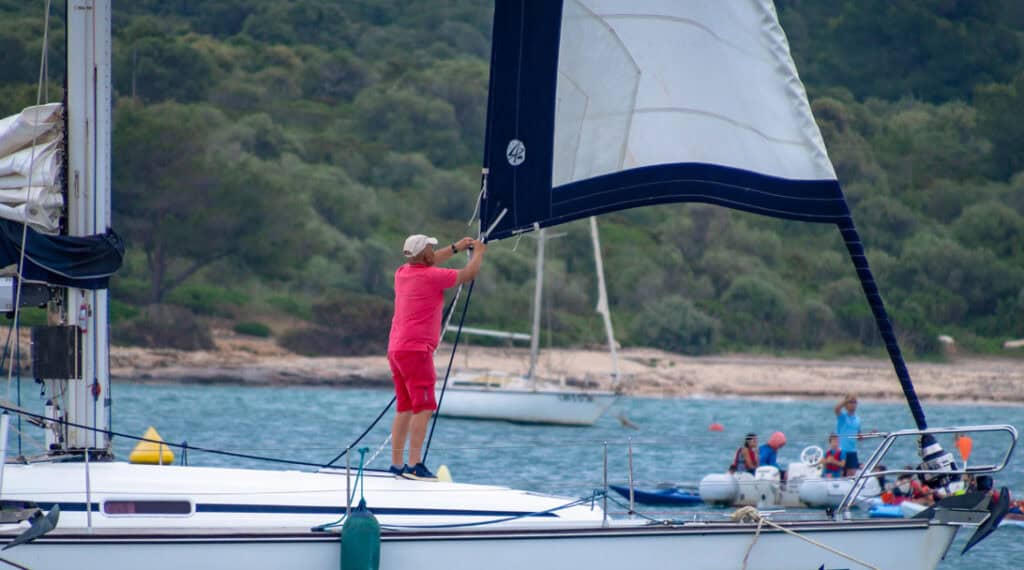Whether your boat is at anchor, on a mooring, tied in the mangroves, at a dock or even hauled out, reducing windage is key to lessening the stress on the boat in a hurricane. This will benefit not only the boat itself, but also any attachment points.
The Principles
Even at anchor or on a mooring, the boat almost never lies perfectly head to wind. At a dock, tied to mangroves or in a boatyard, you can almost guarantee that it won’t be pointing directly into the wind. The smaller the profile of the boat, the less area for the wind to hit and bat it around.
Reducing windage puts less stress on the rig overall. The boat will heel less (heeling or rolling can really add to the wear on items . . . or flat break things). It also reduces chafe on lines and the load on the anchor, mooring, dock, or anything else the boat is attached to.
I’ve written before about the importance of removing roller furling jibs and genoas due to their tendency to unroll and actually cause the boat to sail. But you should also remove other sails (for sailboats) and everything that can be removed from the deck. A bonus is that you’re less likely to break or lose the items themselves!
NOTE: The same advice applies if you are storing your boat for hurricane season. Fully prep it before leaving it; don’t count on someone else to do it once a storm threatens. Every year I hear stories of how the person who was watching a boat simply didn’t have time to fully prep all the boats they were watching.
Specific Tips for Reducing Windage
Walk around your boat deck. You’ll want to reduce windage everywhere you can.
Mainsail
Having a mainsail on the boom is typically 4 to 5 times as large as just the boom. If you feel that you have to leave it on the boom, at least tightly lash it down both to reduce the size and minimize the damage to it. Yes, stackpacks are harder to remove, but they also have more windage than a traditional sail cover.
Canvas
Dodgers and biminis also create significant windage. While you can’t remove hard ones, you should remove canvas covers. This is one reason to attach canvas to frames with zippers. On our first cruising boat, we altered our canvas to add zippers. It was an easy decision after just one bout of hurricane prep where we had to dismantle all the framing to get them off.
During Hurricane Marty, some people left dodgers on to give them protection while on watch in the cockpit. Some of those who did so had significant damage to the canvas. If you will not be on board during the storm, there is no reason to leave any canvas on.
Dinghies and Motors
Dinghies both have considerable windage and can act as mini-sails to catch the wind. If at all possible to store them below deck or in a secure building ashore, do so. Davits are not a good choice. A dinghy that catches wind really adds to the windage. It can also break the davits if it rains harder than your drains can handle. We had 22 inches of rain in one Tropical Storm . If you have to store an inflatable dinghy on deck, deflate it and tie it down extremely securely. Wind will get under it and try to rip it loose. This can cause the big boat to yaw more and quite possibly damage the dinghy. You can sink a hard dinghies can be sunk, but be careful with buoying them as boats may be motoring semi-out-of-control if their anchor dragged or they are trying to avoid a boat that’s dragging.
Remove your dinghy motors and store it as if you were beginning a passage. Again, below deck or securely ashore is great but often the only real choice is on the stern rail.
Above Deck Extras
Bring cockpit cushions should below before the first rain hits.
Bring in flags, burgees, and decorations well ahead of the storm to keep them safe. And yes, they do add a bit of windage and every inch counts.
Any removable lights (Luci lights, Davis lights, other cockpit lights) need to come down. Again, each little thing adds windage. Since they’ll be destroyed if left out in a hurricane, why not?
Leave out your propane tanks (that are not in a propane locker) and fuel jerries outside for safety reasons. We moved them to the cockpit and tied them down. Keep the area that you would steer from clear in case you have to motor during the storm. Bring water jerries inside.
We have always taken in our safety gear (horseshoe buoy and COB pole). The unfortunate reality is that if someone were to go overboard in the storm, the gear is unlikely to be of any practical use in those conditions. It adds windage, and is likely to be torn off the boat or otherwise destroyed in the high winds.
Deck brushes, boat hooks, and other deck gear should all be placed in the lazarette or otherwise brought inside.
Canvas covers for jerry cans, hatches, winches and so on should be removed. With these, it’s not so much the windage as the fact that they are likely to be destroyed.
Solar Panels
It’s preferable to remove solar panels, but that’s not always practical. In Hurricane Marty, we left ours on. The four over the dodger were each attached with four rail clamps; the two larger ones were on the stern rail with two rail clamps each. We folded them down and tied them securely with several independent lines so that if one chafed through, the others would take up the load.
On our next boat, we had one very large (345 watt) panel attached to the dinghy davits. Our initial thought was to leave it in place if a category 1 or 2 storm was forecast. If a category 3 or above storm headed our way, we planned to cut the wires, dismount it and store it inside. In reality, removal is probably preferable in a category 1 storm. It was big and a lot of windage. It could have broken our davits and flying debris could break the panel.
Your Plan to Reduce Windage
Every boat is different as to what’s on deck. Take a walk around your deck and see what you can remove. Swim ladder? Outboard crane? Kayak or SUP? Radar reflector? Cockpit table? Grill? Whisker/spinnaker pole? Add them all to your hurricane prep checklist.
Finally, take photos of your fully prepped boat. Should you have significant damage, photos showing an extremely well-prepared boat will go a long ways in an insurance claim.
Related Posts
Learn clear, actionable steps to plan ahead and protect your boat with confidence this hurricane season.
Get Hurricane Ready

Carolyn Shearlock has lived aboard full-time for 17 years, splitting her time between a Tayana 37 monohull and a Gemini 105 catamaran. She’s cruised over 14,000 miles, from Pacific Mexico and Central America to Florida and the Bahamas, gaining firsthand experience with the joys and challenges of life on the water.
Through The Boat Galley, Carolyn has helped thousands of people explore, prepare for, and enjoy life afloat. She shares her expertise as an instructor at Cruisers University, in leading boating publications, and through her bestselling book, The Boat Galley Cookbook. She is passionate about helping others embark on their liveaboard journey—making life on the water simpler, safer, and more enjoyable.





Leave a Reply